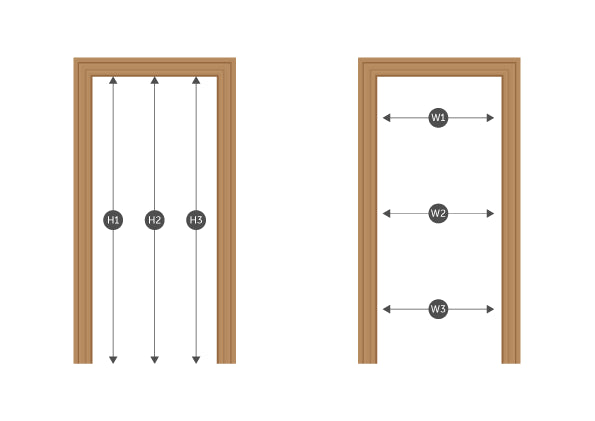When it's time to replace an internal door, precise measurements are key to ensuring a perfect fit and smooth functionality. In this guide, we'll show you how to accurately measure your doorway, making your door replacement journey with UK Oak Doors efficient and hassle-free. Remember, getting these measurements right is crucial to finding a door that not only fits perfectly but also enhances the aesthetic and functionality of your space.
Steps to Measure for a New Internal Door
| Step | Description |
|---|---|
| Step 1 | Measure the Door Width |
| Step 2 | Measure the Door Height |
| Step 3 | Measure the Door Thickness |
| Step 4 | Note the Door Swing |
| Step 5 | Check for Square, Level, and Plumb |
| Step 6 | Final Checks |
Step 1: Measure the Door Width
The width of the door is the first critical measurement. It’s essential to get this right to ensure your new door fits snugly and operates smoothly. Here’s how to do it:
- Use a Tape Measure: Start by taking a tape measure and measuring the existing door or the space where the door will go.
- Measure in Three Places: It's vital to measure the width at the top, middle, and bottom of the door space. Variations in measurements can occur due to uneven frames or wear.
- Record the Widest Measurement: The widest of these three measurements is the one to use when selecting your new door.
Why Width Measurement is Crucial:
- Ensures the door fits without sticking or having gaps.
- Accommodates any unevenness in older door frames.
Step 2: Measure the Door Height
Next, we focus on the height, which is just as important as the width for a seamless fit.
- Measure From the Floor to the Top of the Door Frame: Using your tape measure, measure the height of the door space from the floor to the top of the frame.
- Measure at Three Points: Similar to width measurement, measure at the left, centre, and right sides of the frame.
- Use the Longest Measurement: The tallest measurement out of the three is your go-to number for height.

Importance of Accurate Height Measurement:
- Prevents issues with the door dragging on the floor or having a large gap at the top.
- Addresses any discrepancies in floor level or frame alignment.
Step 3: Measure the Door Thickness
The thickness of your door is a less obvious but equally important dimension to measure.
- Use a Standard Tape Measure: Carefully measure the thickness of the existing door. This is usually done at the edge of the door where it meets the frame.
- Ensuring Frame Fit: The correct thickness ensures your new door will fit into the existing frame without any issues.
The Significance of Thickness Measurement:
- Ensures seamless operation and proper fit within the frame.
- Critical for the door's alignment and locking mechanisms.
Step 4: Note the Door Swing
Understanding the swing of your door is crucial for installation.
- Determine Swing Direction: Observe if your door swings to the right or the left when opened. This is typically viewed from the outside or the most used side.
- Right-Hand or Left-Hand Swing: This will influence the type of door you need and how it will be hung.
Why Door Swing Matters:
- Affects the choice of door handles and hinges.
- Essential for functional door installation and usage.
Step 5: Check for Square, Level, and Plumb
A well-aligned door frame is key to a well-fitting door.
- Frame Alignment: Check that the door frame is square. You can use a spirit level or a laser level for accuracy.
- Dealing with Non-Square Frames: In cases where the frame is not perfectly square, opting for a slightly smaller door might be necessary, which can then be trimmed for a perfect fit.
Checking Frame Alignment:
- Ensures the door hangs straight and closes properly.
- Identifies any need for frame adjustments or a custom-sized door.
Step 6: Final Checks
Before you make your order, here are some final checks:
- Double-Check Measurements: It’s always better to measure twice and order once.
- Consider Irregularities: Any deviations in your measurements should be taken into account. When in doubt, consulting a professional is advisable.
Last-Minute Verifications:
- Guarantees accuracy in your order.
- Reduces the likelihood of errors and subsequent adjustments.
Conclusion
Measuring for a new internal door might seem daunting, but with these straightforward steps, you can achieve accuracy and ensure a perfect fit. Remember, each measurement plays a vital role in the overall functionality and appearance of your door. For a diverse range of quality internal doors, explore the collection at UK Oak Doors, where style meets precision.
FAQs
-
What is the standard size for internal doors in the UK?
Standard internal doors in the UK usually measure 1981mm in height and 762mm in width. However, sizes can vary, so it's important to measure your specific doorway for the best fit.
-
Can I trim an internal door to fit my doorway?
Yes, solid wood doors can often be trimmed to fit. However, there's a limit to how much you can trim without affecting the door's structure. Always check the trimming guidelines for your specific door model.
-
How do I measure a door frame that isn't square?
If your door frame isn’t square, measure the width and height at multiple points and note the smallest measurements. You might need a slightly smaller door that can be trimmed for a precise fit.
-
Do I need to consider the door swing direction when ordering a new door?
Yes, knowing whether you need a right-hand or left-hand swing door is crucial for installation, especially for pre-hung doors or those with pre-drilled hardware holes.
-
What should I do if my measurements are between standard door sizes?
If your measurements don't match standard sizes, consider ordering a bespoke door. UK Oak Doors offers a variety of custom sizes to ensure a perfect fit for your space.


